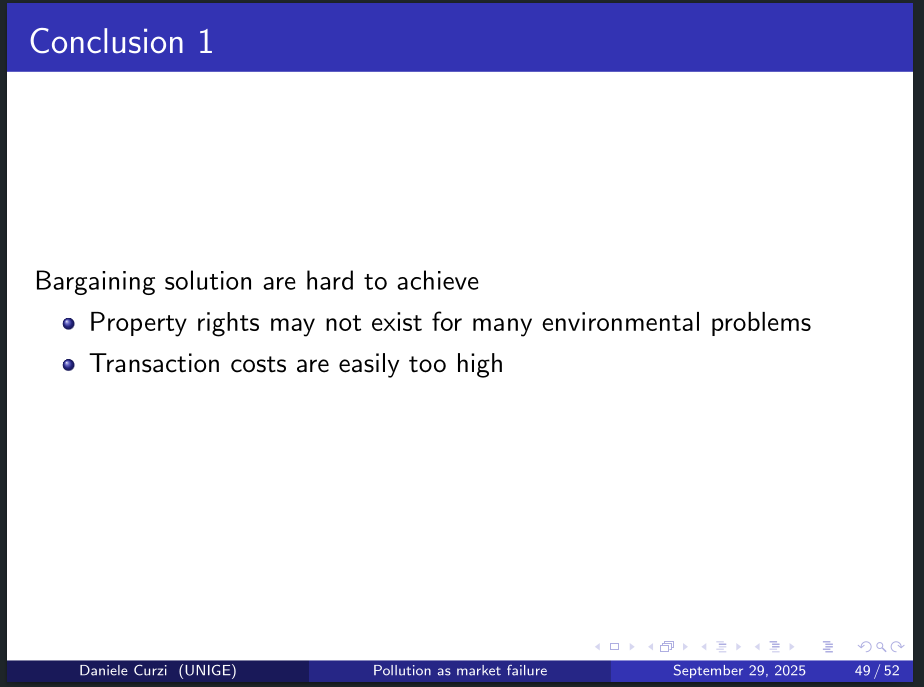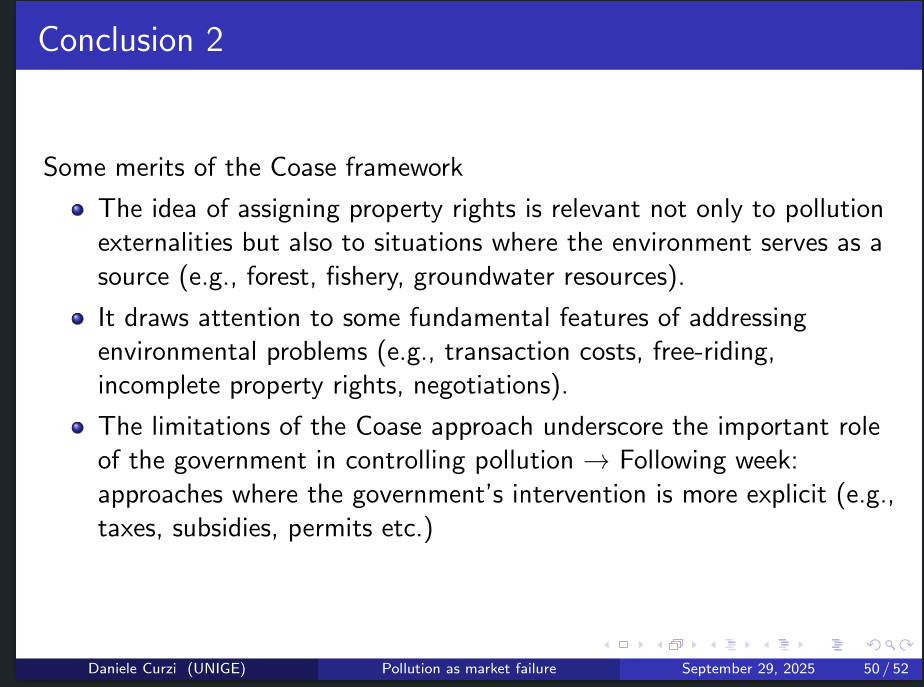The Coase Theorem
Pollution
- Pollution is a side effect of production.
- That is, a specific type of externality.
- Pollution is defined as the introduction of waste and harmful products into an environment that are classed as undesirable.
- It takes many different forms.
Air
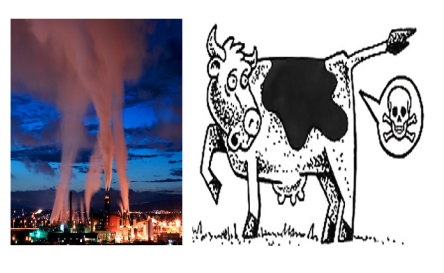
- Methane produced by cows. Agriculture is responsible for 20% of all gas emissions to the atmosphere, it’ll be greatly affected by climate change but is also a huge driver of it.
Water
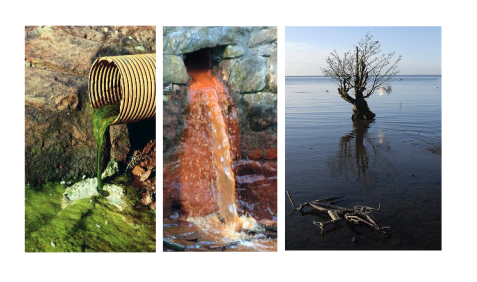
Noise
 E.g.: having a bar next to your house makes its value go down.
E.g.: having a bar next to your house makes its value go down.
Visual
 Windturbines generate renewable energy trough air. However, they also produce a negative externality: visual pollution. The beauty, and as a consequence the value, of the landscape as an economic asset goes down.
Windturbines generate renewable energy trough air. However, they also produce a negative externality: visual pollution. The beauty, and as a consequence the value, of the landscape as an economic asset goes down.
This shows the problems that arise from the fight against climate change, since its solutions are not pollution-free. There is always a cost to pay, and it often comes with negative externalities.
It isn’t just a global problem

What is the optimal level of pollution?
Think for a moment:
- Do you think pollution is justified?
- What is its optimal level? (>0 or <0).
- Why?
- How do we induce economic agents to use the environment in a way that we have determined is desirable?
- Translate individual choices into group or societal?
We don’t want pollution, but it is the necessary cost for many things. Not having pollution means not producing energy. The real dilemma isn’t whether, but how much to produce.
How do we make social choice?
Not everyone has the same opinions, so how to choose what is an acceptable level to pollution (f.ex.)?
- Concept of efficiency in allocation.
- Derive the conditions for the realisation of efficiency.
- Identify the circumstances in which a competitive economy will achieve efficiency.
- Markets.
- We face different preferences over the environment.
Preferences
What is the right balance between environmental protection and use?
- Social and Political questions: No unanimity.
- Very different views… some will be pleased, others disappointed.
Example: italian new regasification vessel
- Italy will fast track the permitting process to set up a new regasification vessel aimed at expanding the country’s capacity to import liquefied natural gas (LNG) in an effort to cut its dependence on Russia.
- The vessel has a capacity of 5 billion cubic metres of gas a year and will remain in the harbour of a small Italian city (Piombino) for three years before being placed offshore.
- Citizens of Piombino are fighting against this decision for different reasons:
- The regasification vessel is too close to the city to be considered safe.
- Environmental and economic damages.
- Despite the Italian government recognises that some of the arguments against the regasificator are understandable, it decided to proceed with its installation.
- Italy’s Ecological Transition Minister said Any delays or obstacles likely to prevent from timely implementation (of the regasification vessel) would be contrary to the interests of Italian citizens and would end up jeopardising the country’s energy security.
- As a form of compensation, the price of gas for the Piombino citizens will be halved.
Example: drilling of arctic national wildlife refuge
- Republicans: drilling could keep America’s economy growing by creating jobs and ensuring that businesses can expand, and less dependent on foreign sources of energy.
- Conservationists: the required network of oil platforms, pipelines, roads and support facilities, not to mention the threat of spills, would play havoc on wildlife (home for some 129,000 caribous).
The circular economy
- The Circular Economy depicts how the environment and the economy are interrelated.
- It is based on Kenneth Boulding’s notion of a Spaceship Economy:
- This portrays the earth as a closed economic system with finite supplies.
- Based on the 1st Law of Thermodynamics (i.e., matter cannot be created or destroyed).
- 1st Law of Thermodynamics: Matter cannot be created or destroyed.
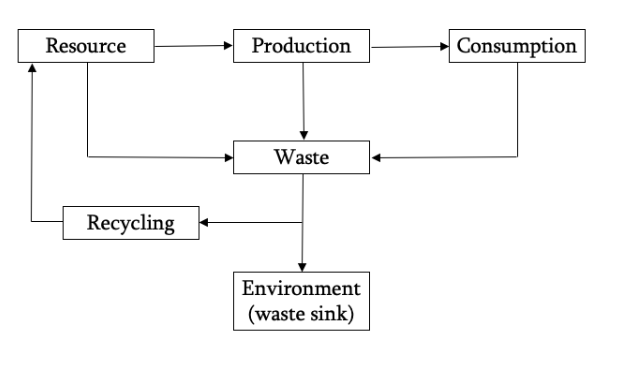 The idea is to not use the waste sink as much as possible, but this depends on current technology. Right now, we can’t recycle everything:
The idea is to not use the waste sink as much as possible, but this depends on current technology. Right now, we can’t recycle everything: - Natural environments are the ultimate repositories of waste products.
- Waste is produced within natural environments and economic systems.
- But not all waste can be recycled: too expensive or difficult (i.e., 2nd Law of Thermodynamics).
Disposing nuclear scores of the Fukushima power plant
- Japan has begun releasing treated radioactive water from its damaged Fukushima power plant into the Pacific Ocean 12 years after a nuclear meltdown.
- The International Atomic Energy Agency says the water will have negligible radiological impact on people and the environment.
- Not all agree on the safety of this procedure.
So
- With small quantities of waste (natural or economic) the environment can typically absorb the waste.
- But with large (localised) quantities of waste the environment may not be able to absorb the waste.
- When they exceed the absorptive capacity of nature, wastes reduce the services that the asset provides (e.g. air pollution can cause respiratory problems; polluted drinking water can cause cancer).
- Therefore, the assimilative capacity of the environment is important.
- If assimilative capacity is exceeded, renewable resources become exhaustible resources.
The function of the environment
- From the Circular Economy the environment provides three functions:
- Supplier of resources.
- Waste assimilation.
- Direct source of utility.
- Dangers arise when we fail to appreciate the positive prices for these economic functions.
Optimal level of pollution
- Need to establish an equilibrium in the economy and the environment to ensure sustainability.
- This suggests that zero pollution is not optimal, as this would mean no economic activity.
- Similarly, too much pollution is not optimal, as the environment can not assimilate all the waste.
- So how to decide the optimal level of pollution?
Modelling pollution within an economic efficiency framework
- Here we consider what the criterion of economic efficiency has to say about determining pollution targets.
- How much pollution we want?
- There are costs and benefits of pollution emissions.
- Less restrictive emissions standard → relaxation of the pollution abatement constraint → production of goods that could not otherwise have been made, or to produce those goods at less direct cost in terms of inputs or techniques employed.
- Stricter pollution targets will not only generate benefits but will also generate costs.
- A simple static model – one in which time plays no role – can be used to identify the efficient level of a flow pollutant.
- Emissions have both benefits and costs:
- The costs of emissions are called damages (negative externality), and are not internalised by the producers.
- Production entails joint products: the intended good or service, and the associated pollutant emissions.
The efficient level of pollution emissions
- An efficient level of emissions is one that maximises the net benefits from pollution.
- Net benefits are defined as pollution benefits minus pollution costs (or damages).
- The level of emissions at which net benefits are maximised is equivalent to the outcome that would prevail if the pollution externality were fully internalised.
Some additional remarks on the net benefits
- Suppose that firms were required to produce their intended final output without generating any pollution.
- This would, in general, be extremely costly (and perhaps even impossible in that limiting case).
- Now consider what will happen if that requirement is gradually relaxed:
- As the amount of allowable emissions rises, firms can increasingly avoid the pollution abatement costs that would otherwise be incurred.
- Therefore, firms make cost savings (and so profit increases) if they are allowed to generate emissions in producing their goods.
- The larger is the amount of emissions generated (for any given level of goods output), the greater will be those cost savings.
Partial equilibrium analysis
- This involves looking at only the part of the economy of direct relevance to the problem of interest.
- We suppose that damage is independent of the time or source of the emissions and that emissions have no effect outside the economy being studied.
- Suppose we are interested in trying to estimate the efficient amount of steel to be produced.
- The partial equilibrium approach starts off by identifying the benefits and costs to society of producing steel.
Efficient emissions: the case of pure flow-damage pollution
- The level of emissions at which net benefits are maximised is equivalent to the outcome that would prevail if the pollution externality were fully internalised.
- In the case of flow pollution, damage (D) is dependent only on the magnitude of the emissions (pollution) flow (M):
- D = D(M).
- We assume that there are also benefits associated with emissions: B = B(M).
- Define: NB = B(M) – D(M).
- Is convenient to work with marginal, rather than total, functions. dB/dM (or B’(M)) is the marginal benefit of pollution dD/dM (or D’(M)) is the marginal damage of pollution.
- We assume that:
- Total damage rises at an increasing rate with the size of the emission flow, and so the marginal damage will be increasing in M.
- Total benefits will rise at a decreasing rate as emissions increase (because per-unit emissions abatement costs will be more expensive at greater levels of emissions reduction). Therefore, the marginal benefit of emissions would fall as their flow increases.
Maximisation of net benefits: emission efficiency condition
- To maximise the net benefits of economic activity, we require that the pollution flow, M, be chosen so that:

- Which states that the net benefits of pollution can be maximised only where the marginal benefits of pollution equal the marginal damage of pollution.
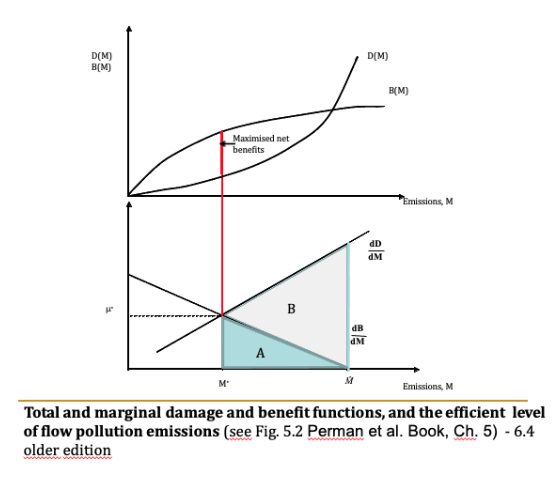
- This is because as long as the marginal benefits are greater we will want to produce more and when the marginal costs are greater we will want to produce less.
- Which states that the net benefits of pollution can be maximised only where the marginal benefits of pollution equal the marginal damage of pollution.
The economically efficient level of pollution
- At M*, Marginal benefit = marginal abatement cost. the sum of total damage costs (the area C2) and total abatement costs (the area C1) and damage costs is C2 + C1.
- Any other level of emissions yields higher total costs: If too little pollution is produced (or too much abatement is undertaken) with a pollution flow restricted to MA , it can be deduced that total costs rise to C1 + C2 + C3, so C3 is the efficiency loss arising from the excessive abatement.
- Efficient level of pollution will not, in general, be zero.
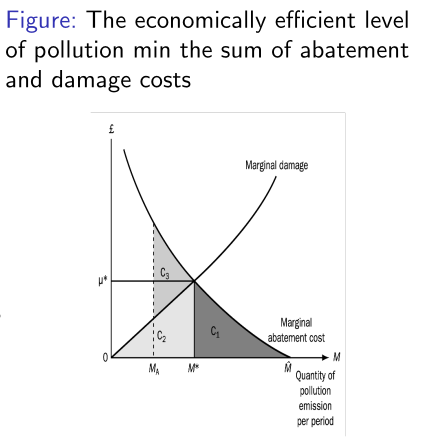

- We could also describe µ∗ as the shadow price of the pollution externality.
- If a market were, somehow or other, to exist for the pollutant itself (thereby internalising the externality) so that firms had to purchase rights to emit units of the pollutant, µ∗ would be the efficient market price.
- µ∗ is the equilibrium price of tradable permits if an amount M ∗ of such permits were to be issued.
- The price of pollution rights becomes that because it is the unique point where firms are just indifferent between paying to abate or paying to pollute. Market forces push the permit price to that level.
How does the market deal with externalities
- Mergers and acquisitions: internalises the externalities.
- Defining the property rights (Coase theorem).
Optimal level of pollution: task I
- Consider two factories along a river: Factory X discharges pollution into the river. Downstream Factory Y uses the water for production.
Coase Theorem
- Suppose I live downstream from you, and you are polluting my water supply.
- Coase argued that if we could either assign property rights to pollute to you or for clean water to me, we could bargain until we found a mutually agreeable solution:
- If you had the right to pollute, you would sell me clean water.
- If I had the right to clean water, I would sell you the right to pollute.
- We would bargain the same outcome irrespective of you and I have the property rights.
- Key assumption: there are no opportunity costs to make a deal (transaction costs are zero).
- Cost to make a deal, trade, or facilitate an exchange of resources.

- Cost to make a deal, trade, or facilitate an exchange of resources.
- Property rights provide the right to use resource.
- Does not matter who holds property right.
- If polluter holds these rights, the level of output will be at Q 1 .
- If sufferer holds these rights, the level of output will be at Q 0 .
- Assumes perfect competition.
- Assumes transaction costs = 0.
- Assumes perfect information.
But
- However, if both parties can bargain, then the polluter would compensate sufferer an amount less than what he gains in profit but more than sufferer loses.
- This results in a social improvement.
- They would continue to bargain until the point where no compensation can occur, i.e., Q*.
- Social optimum occurs regardless of who holds property rights:
- Therefore no need for intervention.
Example:Fontainebleau vs. Eden Roc Hotel
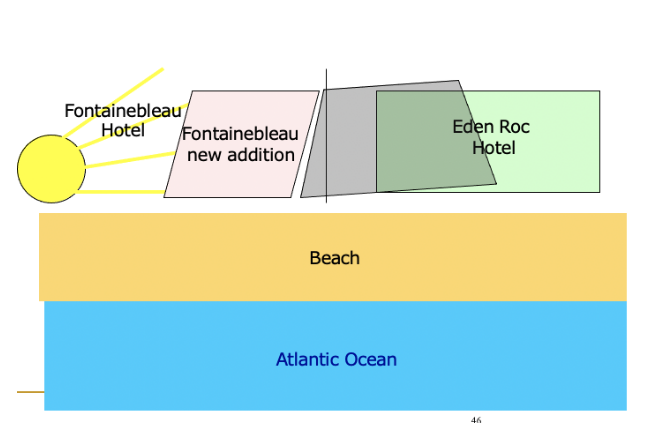 Difficult to assign rights and prices here tho.
Difficult to assign rights and prices here tho.
Coase-theorem part II
- If there are no transaction costs, all required to achieve efficiency is the definition of property rights over the resource through which the externality is mediated.
- Once property rights have been defined, the relevant parties (i.e., the polluter and the party affected by pollution) will be able to achieve an efficient outcome by trading those rights in the market.
Criticisms
- Applies in cases where there is perfect competition.
- There is a lack of real-life examples.
- Which may suggest problems with the application, e.g., transaction costs.
- Difficulty in identifying the polluters and the sufferers.
- ‘Free riders’ may not ‘play fair.’
- Potential for bribery/threat making.
- Difficultly in determining the costs and benefits.
- Gains and losses are not perceived the same, leading to stalemate negotiations.
- Transaction costs:
- Broadly speaking, equal all the costs associated with negotiations (e.g., cost of identifying the relevant parties; bargaining process itself; establishing, executing, and monitoring the outcome of negotiations etc.).
- If transaction costs exceed the possible negotiation gains, the Coase solution will not work.
